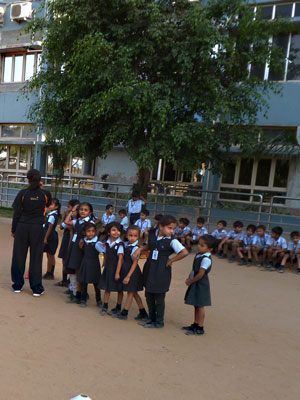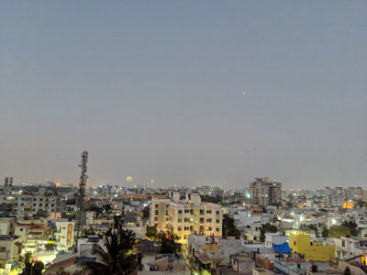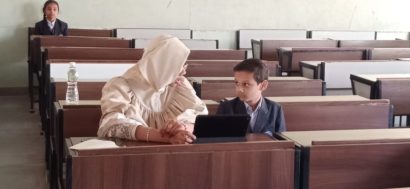Hindu kids more apt to echo propaganda that ‘Indian equals Hindu’
With a multi-faith population of some 1.3 billion, India claims to be the world’s largest secular democracy.
But when it comes to the question of who is a true Indian, the country’s Hindu children are more likely than their Muslim peers to connect their faith to their national identity, according to new research from UC Berkeley.

The findings, published in the journal Child Development, are particularly timely in the face of the Indian government’s recent annexation of Muslim-majority Kashmir and the removal of nearly 2 million Muslims from Assam’s citizenship rolls.
Researchers at UC Berkeley and Yale University sought to understand how rising Hindu nationalism under Indian Prime Minister Narendra Modi and his ruling Bharatiya Janata Party might be internalized by both Hindu and Muslim children.
“Our results indicate that by age 9, Hindu children have already internalized an ‘Indian equals Hindu’ association, and we show that this association predicts children’s support for policies that favor Hindus over Muslims,” said study senior author Mahesh Srinivasan, an associate professor of psychology at UC Berkeley.
On a more hopeful note, the study also suggests that Muslim children feel no less Indian because of their faith, indicating they are shielded from religious nationalist messaging and able to identify both as Indian and as Muslim, added Srinivasan, a California native who is of South Indian Hindu descent.
“If Muslim children were to equate being Indian with being Hindu, they could very well feel conflicted about being Indian or being Muslim. We know from other research that disconnection from one’s own national, ethnic, or religious group is bad for mental health and other life outcomes,” he said.

Through surveys and social psychology measures, the researchers examined the explicit and implicit associations and attitudes of 160 schoolchildren aged between 9 and 16 in Vadodara, an industrial city in Gujarat, a western state where communal riots in 2002 left some 1,000 Indian Muslims dead. All the children attended Zenith, a charitable school for low-income children in Vadodara.
The children, 79 of whom were Hindu and 81 of whom were Muslim, were each given an implicit association test, which asked them to swiftly pair together words and pictures.
The results showed that Hindu children more readily paired images associated with India with the word “Hindu” and images associated with foreign countries with “Muslim,” suggesting that they think of India as primarily a Hindu nation.
By contrast, Muslim children were just as fast at pairing Indian images with the words “Hindu” or “Muslim.” India is home to about 900 million Hindus and 200 million Muslims, as well as Christians, Sikhs, Buddhists, Jews and offshoots of these groups.
While nationalist populism is by no means unique to India — and is surging globally — the rise of India’s BJP party, which was founded in 1980, shows how easily a country can be divided along ethno-religious lines, and how the attitudes of children might come to mirror propaganda efforts, researchers said.
“Individually, we found that children who held stronger associations between being Indian and being Hindu were also more likely to support regressive social policies favoring Hindus over Muslims, and organizations promoting Hindu nationalist goals,” said study lead author Monica Ellwood-Lowe, a Ph.D. student in psychology at UC Berkeley.
The study was conducted in Gujarat, where Modi served as chief minister in 2002 when a fire on a train killed 59 Hindu pilgrims and communal violence broke out.
At the time, Modi was accused of inciting sectarian violence, but was cleared of wrongdoing in 2012 by a committee appointed by the Indian Supreme Court. In 2014, he and his BJP party were elected in a landslide victory. He has since attracted a massive following among Hindu nationalists, earning India the moniker of “Modistan.”
Srinivasan, a graduate of Stanford and Harvard who joined UC Berkeley’s psychology faculty in 2013, has been traveling to Vadodara with his team of graduate students and other collaborators over several years. They have studied a variety of topics in the face of rising Hindu nationalism, including children’s implicit biases, reasoning about religious differences, and segregation in social networks.

While the data they have collected so far signals a mutual acceptance, if not the potential for a peaceful coexistence between Hindus and Muslims, Srinivasan acknowledges the situation is volatile.
“At this point, Hindu-Muslim relations in India could either steer toward more conflict or toward more tolerance based on mutual respect,” said Srinivasan. “That’s why it’s more critical than ever to understand the conditions that promote tolerance and inclusivity among children.”
Next, Srinivasan will study children’s understanding of and attitudes toward religious differences in Israel and in the United States.
In addition to Srinivasan and Ellwood-Lowe, co-authors of the study are Catherine Berner of UC Berkeley and Yarrow Dunham of Yale University.
